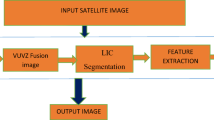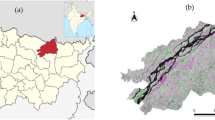Abstract
Taking Dongting Lake district as the studying area and utilizing multi-temporal MOS-1b/MESSR data as remote sensing info source, by the combination operation and ratio transform processing and the image, spectrum and histogram comparison of the MESSR image data of all bands for the flood season and dry season with the ERDAS IMAGINE system, a classification model was established, which can be used to acquire the spatial distributing information of water bodies. Meanwhile a water depth index model was derived and built, and then a model for detecting the depth of water body based on the non-linear recursive analysis was presented. By the overlay analysis of the classification thematic images based on the model for extracting flood information, the flooding area and distributing information were acquired.
Similar content being viewed by others
References
ZHANG Ji-qun, ZHOU Cheng-hu, XU Kai-qin, et al. Flood disaster monitoring and evaluation in China[J]. Journal of Environmental Hazards, 2002, 4(2–3): 33–43.
Spivak L, Arkhipkin O, Ankratov V, et al. Space monitoring of floods in Kazakhstan[J]. Journal of Mathematics and Computers in Simulation, 2004, 67(4–5): 365–370.
LIU Quan. Study on application of GIS to monitoring disasters in floodplain[J]. Scientia Geographica Sinica, 2002, 22(6): 712–716. (in Chinese)
CHEN De-qing, YANG Cun-jian, HUANG Shi-feng. A study on inversion of spatial distribution of maximum in undated depths of floods by use of GIS method [J]. Journal of Catastrophology, 2002, 17(2): 1–6. (in Chinese)
Einar-Arne H. IGOS (integrated global observing strategy) water cycle theme report [R]. Noordwijk: European Space Agency Earth Observation Science and Applications Department, 2004.
CAO Shu-hu. The research and application of the remote sensing system of flood control[J]. Journal of EMCC, 2004, 14(1): 22–24. (in Chinese)
PENG Ding-zhi, GUO Sheng-lian, HUANG Yu-fang, et al. Flood disaster monitoring and assessing system based on MODIS and GIS[J]. Engineering Journal of Wuhan University, 2004, 37(4): 7–11. (in Chinese)
David T M, Roland B G, Victor Z, et al. Satellite remote sensing of earthquake, volcano, flood, landslide and coastal inundation hazards[J]. ISPRS Journal of Photogrammetry and Remote Sensing, 2005, 59(4): 185–198.
CHEN Xiu-wan. Study on flood disaster analysis system based on remote—sensing and its application[J]. Chinese Science Abstracts Series B, 1995, 14(2): 71.
TONG Qing-xi. Role of remote sensing in flood monitoring in 1998[J]. Climatic and Environmental Research, 1998, 3(4): 314–322. (in Chinese)
ZHAO An. Comparison study of three sub-pixel calculation methods-Case study of flood monitoring in Poyang Lake region with NOAA AVHRR[J]. Remote Sensing Technology and Application, 2005, 20 (2): 265–271. (in Chinese)
Singhroy V. SAR integrated techniques for geohazard assessment[J]. Advances in Space Research, 1995, 15(11): 67–78.
ZHOU Xiao-long, LIN Dan-dan, YANG Hui-ming, et al. Use of landsat TM satellite surveillance data to measure the impact of the 1998 flood on snail intermediate host dispersal in the lower Yangtze River Basin[J]. Acta Tropica, 2002, 82(2): 199–205.
DAI Chang-da. The theory and practice on monitoring and evaluating forestry fire, insect disaster and flood by TM [J]. Environmental Remote Sensing, 1993, 8(2): 105–111. (in Chinese)
YU De-qing, PI Jian-gao. Dongting Lake district Bedload’s filling up crust subsidence remote sensing research[J]. Hunan Geology, 2002, 21(1): 46–50. (in Chinese)
DU Yun, CAI Shu-ming, ZHANG Xiao-yang, et al. Interpretation of the environment change of Dongting Lake, middle reach of Yangtze River China, by 210Pb measurement and satellite image analysis[J]. Geomorphology, 2001, 41(2–3):171–181.
YIN Yong-long. The study pulse of remote sensing technology in Japan[J]. Remote Sensing for Land & Resources, 1994, 19(1): 56–60. (in Chinese)
ZHOU Cheng-hu, LUO Jian-cheng, YANG Xiao-mei, et al. Geological interpretation and analysis of remote sensing images [M]. Beijing: Science Press, 2001. (in Chinese)
DAI Chang-da, JIANG Xiao-guang, TANG Ling-li. The processing and analysis of remote sense image [M]. Beijing: Tsinghua University Press, 2004. (in Chinese)
LIU Jian-bo, DAI Chang-da. The application of TM image in reservoir situation monitoring[J]. Remote Sensing of Environment, 1996, 11(1): 54–58. (in Chinese)
Author information
Authors and Affiliations
Corresponding author
Rights and permissions
About this article
Cite this article
Mao, Xc., Xiong, Lh. & Isao, T. Application of MOS-1b/MESSR data to flood monitoring of Dongting Lake. J Cent. South Univ. Technol. 13, 110–115 (2006). https://doi.org/10.1007/s11771-006-0116-3
Received:
Accepted:
Published:
Issue Date:
DOI: https://doi.org/10.1007/s11771-006-0116-3




